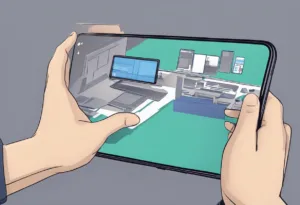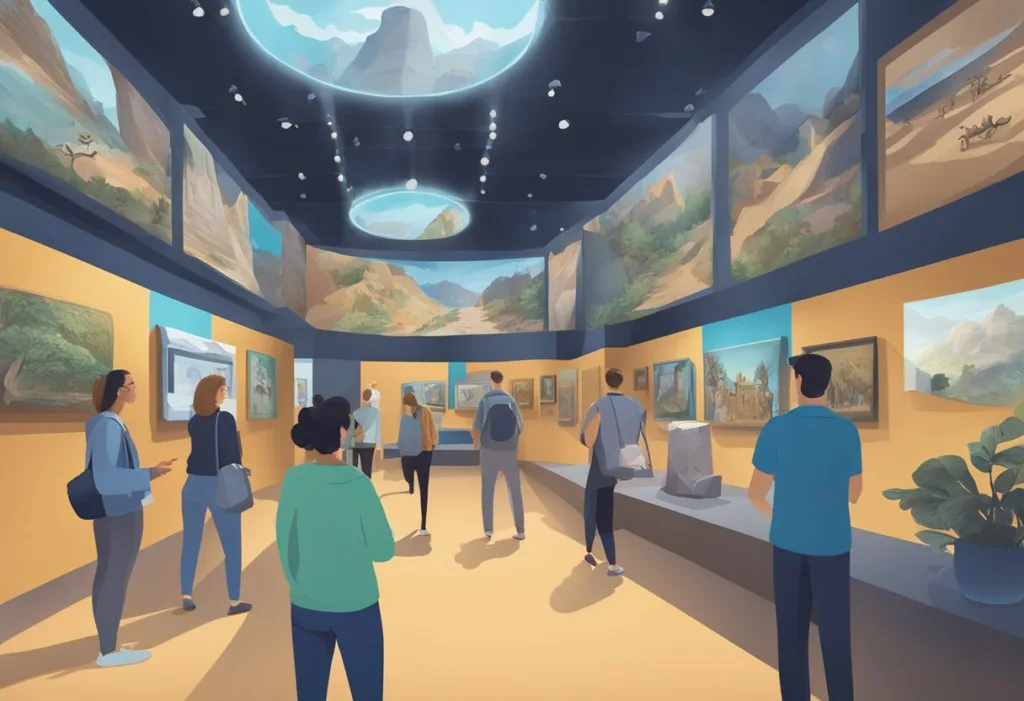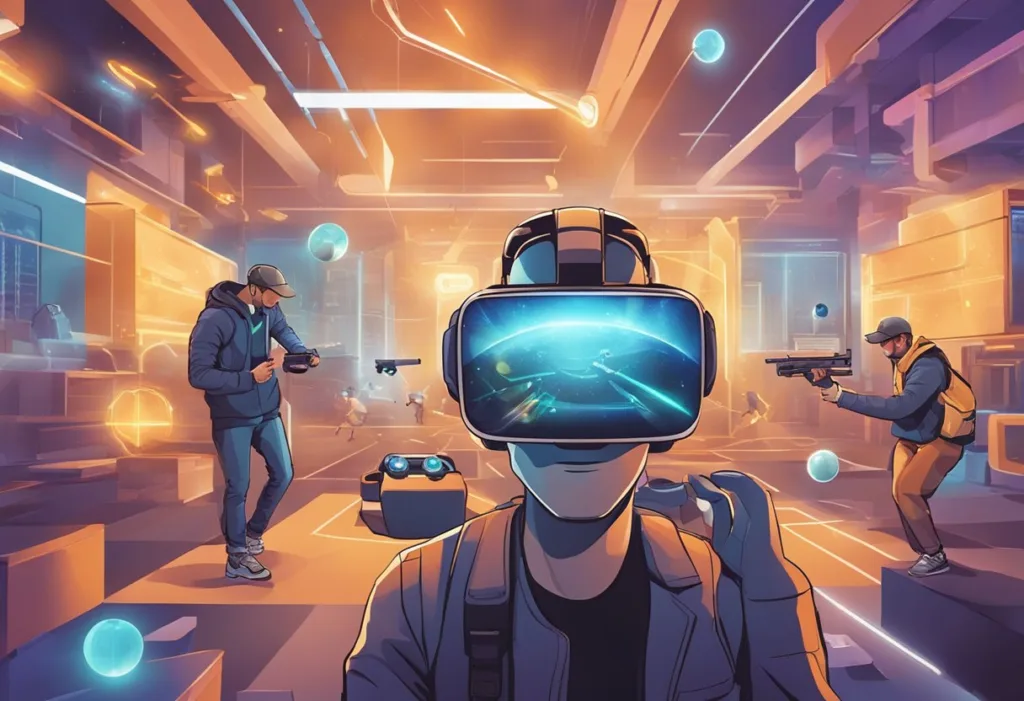Augmented reality (AR) is a technology that has the potential to revolutionize the way we interact with digital content. It allows users to overlay virtual objects onto the real world, creating a mixed reality experience that can be used for a wide range of applications. From gaming to education, AR has already made an impact in various industries, and its potential is only growing. In this blog post, I will share with you a step by step guide on how to use AR applications.
Understanding how to use AR can seem daunting at first, but it’s actually quite simple. Generally speaking, AR apps let users “see” through the cameras on their devices. The apps then add data delivered from the Internet to the image being shown. Unlike virtual reality (VR), which creates a completely simulated world, AR adds digital elements to the existing world. This means that AR can be used to enhance real-world experiences, rather than replacing them entirely.
AR hardware and software are becoming increasingly accessible, with many smartphones and tablets now equipped with AR capabilities. There are also a growing number of AR apps available on app stores, making it easier than ever to get started with AR. Whether you’re interested in creating engaging AR experiences or simply want to explore the possibilities of this exciting technology, there’s never been a better time to learn how to use AR.
Key Takeaways
- Augmented reality (AR) allows users to overlay virtual objects onto the real world, creating a mixed reality experience that can be used for a wide range of applications.
- Unlike virtual reality (VR), which creates a completely simulated world, AR adds digital elements to the existing world, making it possible to enhance real-world experiences.
- AR hardware and software are becoming increasingly accessible, with many smartphones and tablets now equipped with AR capabilities, and a growing number of AR apps available on app stores.
The Basics of AR
Augmented Reality (AR) is a technology that overlays digital information onto the physical world in real-time. The technology enhances the user’s perception of the real world by adding computer-generated graphics, sounds, and haptic feedback. AR is different from Virtual Reality (VR), which creates a completely digital environment. AR allows users to interact with the real world while also experiencing digital content. AR is commonly used in mobile devices, head-mounted displays, and smart glasses.
AR technology has been around since the 1960s, when Ivan Sutherland created the first head-mounted display. However, it was not until the development of mobile devices and smart glasses that AR became widely accessible to the public. Today, AR is used in a variety of industries, including education, healthcare, entertainment, and manufacturing.
AR vs VR: Differences and Similarities
AR and VR are two different technologies that are often compared. While both technologies are used to enhance the user’s perception of reality, they work in different ways. VR creates a completely digital environment, while AR overlays digital information onto the real world. VR is commonly used in gaming and entertainment, while AR is used in a variety of industries.
One similarity between AR and VR is that they both require a device to experience the technology. VR requires a headset, while AR can be experienced through a mobile device or smart glasses. Both technologies also require powerful hardware and software to create a seamless experience for the user.
The Evolution of AR Technology
AR technology has come a long way since its inception in the 1960s. The technology has become more accessible to the public with the development of mobile devices and smart glasses. In 2013, Google Glass was released, which allowed users to experience AR through a pair of glasses. However, the technology was not widely adopted due to privacy concerns and the high cost of the device.
Microsoft released the HoloLens in 2016, which is a pair of smart glasses that allows users to experience AR. The device has been used in a variety of industries, including healthcare and manufacturing. The HoloLens is still considered a high-end device and is not widely accessible to the public.
AR is a technology that overlays digital information onto the real world in real-time. The technology has been around since the 1960s and has become more accessible to the public with the development of mobile devices and smart glasses. AR and VR are two different technologies that are often compared, but they work in different ways. AR has come a long way since its inception and is now being used in a variety of industries.
How to Use AR: A Beginner’s Guide

Here’s a general step-by-step guide that applies to most AR experiences:
Step 1: Choose an AR-Compatible Device
Ensure you have a device that supports AR. Most modern smartphones and tablets come with AR capabilities. Check your device’s specifications or app store to confirm it can run AR applications.
Step 2: Download an AR Application
Browse your device’s app store (e.g., Apple App Store, Google Play Store) to find an AR application that interests you. Look for apps with good reviews and ratings. Download and install your chosen AR app.
Step 3: Grant Necessary Permissions
When you first launch the AR app, it may ask for permissions to access certain features on your device, such as the camera or your location. Grant the necessary permissions for the app to function correctly.
Step 4: Follow On-Screen Instructions
Most AR apps will provide on-screen instructions to guide you through the process of using the application. This may include how to calibrate the app by scanning your environment or placing virtual objects.
Step 5: Scan Your Environment
Many AR apps require you to scan your surroundings to anchor virtual objects in the real world. Point your device’s camera at the area where you want to use AR and move it around as instructed by the app until it recognizes the space.
Step 6: Interact with the AR Content
Once the app has recognized your environment, virtual content will appear on your device’s screen, overlaid onto the real world. Interact with this content as directed by the app. This could involve touching the screen, moving your device, or physically moving around the space.
Step 7: Customize Your Experience
Some AR apps allow you to customize the experience by changing settings, selecting different virtual objects, or modifying the virtual environment. Explore the app’s features to tailor the AR experience to your liking.
Step 8: Save or Share Your Experience
If the app allows, you can often take photos or videos of your AR experience to save for later or share with others. Look for a camera or share icon within the app to use this feature.
Step 9: Close the App Safely
When you’re finished using the AR app, make sure to close it properly to conserve battery life and processing power. Some AR apps can be quite demanding on your device’s resources.
Step 10: Stay Aware of Your Surroundings
While using AR applications, it’s essential to remain aware of your surroundings to ensure your safety and the safety of others. Avoid using AR apps in hazardous areas or situations where your attention is required elsewhere.
AR Hardware and Software
AR is a technology that requires specialized hardware to function. The essential hardware components for AR include sensors, displays, lenses, and cameras. These components work together to create an immersive experience for the user.
Sensors are used to track the user’s movements and position in real-time. Displays and lenses are used to overlay digital content onto the real-world environment. Cameras are used to capture the real-world environment and feed it into the AR system.
Choosing the Right AR Software
Choosing the right AR software is crucial for creating a successful AR application. There are several leading AR development platforms available, including Apple’s ARKit, Google’s ARCore, and Unity.
Apple’s ARKit is a powerful AR development platform that provides developers with the tools they need to create immersive AR experiences for iOS devices. Google’s ARCore is a similar platform that is designed for Android devices. Unity is a cross-platform game engine that supports AR development for multiple platforms.
When choosing an AR development platform, it is important to consider factors such as the platform’s features, ease of use, and compatibility with your target devices.
Leading AR Development Platforms
Apple’s ARKit is a leading AR development platform that is designed specifically for iOS devices. ARKit provides developers with a range of tools and features for creating immersive AR experiences, including support for 3D object detection and tracking, face tracking, and more.
Google’s ARCore is a similar platform that is designed for Android devices. ARCore provides developers with a range of tools and features for creating immersive AR experiences, including support for motion tracking, environmental understanding, and more.
Unity is a cross-platform game engine that supports AR development for multiple platforms. Unity provides developers with a range of tools and features for creating immersive AR experiences, including support for 3D object detection and tracking, face tracking, and more.
Choosing the right AR development platform is crucial for creating a successful AR application. It is important to consider factors such as the platform’s features, ease of use, and compatibility with your target devices.
AR in Different Industries
Augmented Reality (AR) is a technology that is becoming increasingly popular in various industries. AR is a combination of digital and audiovisual elements that enhances the real world around us. This section will explore the different industries where AR is having an impact.
AR in Retail and E-commerce
AR is having a significant impact on the retail and e-commerce industry. Companies like IKEA and Amazon are using AR to create a more immersive shopping experience for their customers. IKEA Place, for example, is an AR app that allows customers to see how furniture will look in their home before making a purchase. This technology has the potential to increase customer satisfaction and reduce returns.
Impact of AR in Healthcare
AR is also having a significant impact on the healthcare industry. Companies like Boeing are using AR to train medical professionals to perform complex procedures. AR enables medical professionals to practice procedures in a safe and controlled environment, reducing the risk of errors during real procedures. AR is being used to create more accurate medical simulations, which can help medical professionals diagnose and treat patients more effectively.
AR in Education and Training
AR is transforming the way education and training are delivered. AR enables students to visualize complex concepts and interact with them in a more immersive way. For example, medical students can use AR to explore the human body in detail, while engineering students can use AR to visualize complex machinery and equipment.
The Role of AR in Entertainment and Gaming
AR is having a significant impact on the entertainment and gaming industry. Games like Pokémon Go have shown the potential of AR to create immersive gaming experiences. AR is being used in advertising to create more engaging and interactive campaigns. AR is also being used in the tourism industry to create virtual tours of popular tourist destinations.
AR is a technology that is having a significant impact on various industries, including retail, healthcare, education, and entertainment. AR has the potential to create more immersive experiences for customers, improve training and education, and create more engaging entertainment and gaming experiences.
Creating Engaging AR Experiences
Designing for User Interaction
Creating engaging AR experiences requires designing for user interaction. This means creating an experience that is intuitive and easy to use. The user should be able to interact with the AR elements in a natural way, without having to think too hard about what they need to do. To achieve this, designers need to consider the user’s perspective and how they will interact with the AR elements. They should also consider the user’s physical movement and how they will interact with the environment in which the AR experience takes place.
Incorporating Physical and Digital Elements
To create an immersive AR experience, it is important to incorporate both physical and digital elements. This means designing an experience that seamlessly blends the physical world with digital elements. The physical world should be used as a canvas for the digital elements, creating a seamless and immersive experience for the user. Designers should consider how the digital elements will interact with the physical environment and how the user will interact with both the physical and digital elements.
Enhancing Realism in AR
To enhance the realism of an AR experience, designers should consider the sensory experience of the user. This means incorporating sound, touch, and other sensory elements into the AR experience. For example, if the user is interacting with a virtual object, they should be able to feel the object’s texture and weight. The sound should also be synchronized with the user’s movements, creating a more realistic and immersive experience. Designers should also consider the real-time nature of AR and how the experience will change as the user moves through the environment.
Creating engaging AR experiences requires designers to consider the user’s perspective and how they will interact with the AR elements. Designers should also incorporate both physical and digital elements to create a seamless and immersive experience. To enhance the realism of the AR experience, designers should consider the sensory experience of the user and how the experience will change in real-time. By following these guidelines, designers can create AR experiences that are both engaging and memorable for the user.
The Future of Augmented Reality
As technology continues to advance, so does the potential for Augmented Reality (AR) to revolutionize the way we interact with the world around us. With the AR market expected to grow significantly in the coming years, it is important to take a closer look at the emerging trends in AR and its potential for growth.
Emerging Trends in AR
One of the most exciting trends in AR is the growth of the Metaverse, a virtual world where users can interact with each other in real-time. This concept has been popularized by games like Second Life and is now being explored by companies like Microsoft with its HoloLens mixed reality headset. As more people begin to explore the potential of the Metaverse, we can expect to see new and innovative applications of AR technology.
Another emerging trend in AR is the convergence of AR and AI. Machine learning algorithms are being developed to help AR systems recognize objects in the real world and provide users with relevant information. This technology has the potential to revolutionize industries like healthcare and retail, where AR can be used to provide personalized recommendations and information.
AR and the Growth of the Metaverse
The growth of the Metaverse is expected to have a significant impact on the AR market. As more people begin to explore virtual worlds, the demand for AR technology that can provide a seamless transition between the real and virtual worlds will continue to grow. This presents an opportunity for companies like Microsoft, which is already investing heavily in AR technology, to take a leading role in the development of the Metaverse.
The Convergence of AR and AI
The convergence of AR and AI has the potential to revolutionize the way we interact with the world around us. By using machine learning algorithms to recognize objects in the real world, AR systems can provide users with personalized information and recommendations. This technology has the potential to transform industries like healthcare, where AR can be used to provide doctors with real-time information about patients.
The future of AR is bright, with emerging trends like the growth of the Metaverse and the convergence of AR and AI set to revolutionize the way we interact with the world around us. As the AR market continues to grow, we can expect to see new and innovative applications of this technology that will change the way we live, work, and play.
Frequently Asked Questions
What are the steps to activate AR on my smartphone?
Activating AR on your smartphone is a simple process. First, ensure that your smartphone is compatible with AR. Most modern smartphones are compatible with AR, but you can check with your device manufacturer to confirm. Once you have confirmed compatibility, download an AR app from your device’s app store. Launch the app and follow the prompts to activate AR. Some apps may require additional permissions to access your device’s camera and other features. Follow the prompts to grant these permissions and start using AR on your smartphone.
Which AR SDK is recommended for developing augmented reality apps?
There are several AR software development kits (SDKs) available for developing augmented reality apps. The choice of SDK depends on the specific requirements of your app. Some popular AR SDKs include ARKit (for iOS), ARCore (for Android), Vuforia, and Wikitude. These SDKs offer a range of features and tools for developing AR apps, including 3D object recognition, image tracking, and more. It is recommended that you research each SDK and choose the one that best suits your needs.
How can I create AR art using my mobile device?
Creating AR art using your mobile device requires an AR app that supports AR art creation. There are several AR art creation apps available on both iOS and Android devices. Some popular AR art creation apps include Artivive, SketchAR, and Just a Line. These apps allow you to create AR art by drawing or painting on your device’s screen. Once you have created your AR art, you can share it with others by exporting it as an AR file.
What is the process for using AR features on an iPad?
Using AR features on an iPad is similar to using AR on an iPhone. First, ensure that your iPad is compatible with AR. Most modern iPads are compatible with AR, but you can check with your device manufacturer to confirm. Once you have confirmed compatibility, download an AR app from the App Store. Launch the app and follow the prompts to activate AR. Some apps may require additional permissions to access your device’s camera and other features. Follow the prompts to grant these permissions and start using AR on your iPad.
Can you explain how to use AR animation applications effectively?
AR animation applications allow you to create 3D animations that can be viewed in augmented reality. To use these applications effectively, it is important to have a basic understanding of 3D animation principles. You should also be familiar with the specific features and tools offered by the application you are using. Some popular AR animation applications include Adobe Aero, Unity, and ARToolKit. It is recommended that you research each application and choose the one that best suits your needs.
What are the most common uses of augmented reality by consumers today?
The most common uses of augmented reality by consumers today include gaming, shopping, and education. AR gaming allows users to experience immersive gameplay by overlaying digital elements onto the real world. AR shopping allows users to preview products in their real-world environment before making a purchase. AR education allows students to engage with educational content in a more interactive and engaging way. Other common uses of AR include navigation, advertising, and social media.














